SCOTUS Could Shackle EPA
Air Date: Week of March 4, 2022
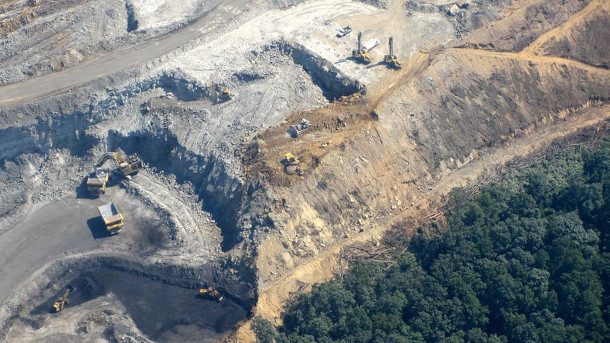
Coal mining in the State of West Virginia, the lead plaintiff in the case West Virginia v. EPA. (Photo: Delta Whiskey, Flickr CC BY-NC-ND 2.0)
The US Environmental Protection Agency has a legal duty to regulate greenhouse gases as harmful air pollutants. But a more conservative US Supreme Court recently heard oral arguments in a case that could significantly limit the tools EPA can use to curb these emissions from power plants, even though such rules don’t yet exist. Vermont Law School Professor Pat Parenteau joins Host Steve Curwood to discuss the risks the case West Virginia v. EPA pose to environmental regulation writ large.
Transcript
DOERING: From PRX and the Jennifer and Ted Stanley studios at the University of Massachusetts, Boston this is Living on Earth. I’m Jenni Doering
CURWOOD: And I’m Steve Curwood.
Congress has yet to enact comprehensive climate legislation, so if the Biden administration wants to set America on track for net zero carbon emissions by 2050 it will have to rely on executive orders and regulations. According to a landmark ruling by the US Supreme Court in 2007 CO2 is an air pollutant that the Environmental Protection Agency must regulate. But so far EPA efforts to actually curb the large amounts of global warming gases from power plants have gotten snarled in litigation. And just the other day a more conservative Supreme Court heard arguments in a case that could tie the hands of the EPA, even though those rules don’t even exist. Joining me now to discuss is Pat Parenteau, Professor at the Vermont Law School and former EPA Regional Counsel. Welcome back to Living on Earth, Pat!
PARENTEAU: Thanks, Steve, good to be with you.
CURWOOD: So, Pat, I'm confused. Conservatives have said for a long time that judges shouldn't be activists. But to what extent is this so-called conservative Supreme Court changing along those lines?
PARENTEAU: Oh, right. I mean, they're reaching out for cases that in the past, the Supreme Court would never take. The big kahuna case on the calendar of the Supreme Court this year, the West Virginia versus EPA case involving regulation of greenhouse gases from power plants, for example, there is no rule on the books right now regulating these emissions. So the Supreme Court has taken review of an abstract question of what is EPA's authority to regulate these plants before the Biden administration has even adopted a rule! It's the very definition of an activist court.
CURWOOD: So West Virginia v. the Environmental Protection Agency, has been called by some as the biggest climate change case in a decade. What makes it such a big deal?
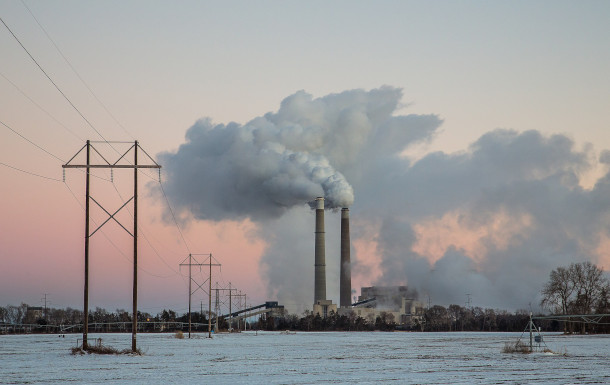
Xcel Energy’s Sherburne County (Sherco) Generating Station, a coal-fired power plant, near Becker, Minnesota. (Photo: Tony Webster, Wikimedia Commons CC BY-SA 2.0)
PARENTEAU: Well, it certainly is since Massachusetts v. EPA. This decision, could you know, not only limit EPA's authority under the Clean Air Act. But one of the doctrines is something called the major question doctrine. It's a rule that the court and the conservative members would view as kind of a new assertion of authority that an agency hasn't previously used under a provision of a law like the Clean Air Act, that's been on the books since 1970. But it's never been used for anything as big as climate, of course, because we weren't thinking about climate change in 1970, we should have been, but we weren't. And this doctrine is so malleable, that you know, you can apply it to any environmental rule. I mean, most environmental rules, because they're addressing big problems -- air quality, water quality, loss of wetlands, loss of endangered species -- they're dealing with really big problems that do have large economic and social consequences. Some of those consequences are negative from the standpoint of if we don't deal with the problems they're gonna create, you know, economic harm, and other kinds of harm. And if we do deal with them, it's going to cost money to deal with them. But if we don't deal with them sooner rather than later, the cost could be much greater, and so on. The problem is when the court applies the major question doctrine, guess what? The result is almost every single time, in fact, all the cases that I'm aware of is the agency regulation is struck down. It's a deregulatory doctrine. It's used when the court believes the agency has exceeded its authority, and is gonna strike down the rule and require that Congress explicitly authorize the specific action that the agencies want to take. And that's just a recipe for disaster, frankly, for environmental law. We have to be much more adaptive than that.
CURWOOD: This case that we're talking about is called West Virginia v. the EPA. What's the backstory of this case, and explain in some detail the EPA regulation that it's talking about.
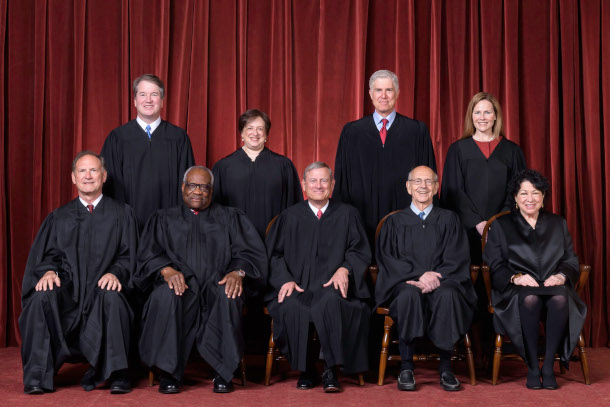
The current members of the Supreme Court of the United States. Front row, left to right: Associate Justice Samuel A. Alito, Jr., Associate Justice Clarence Thomas, Chief Justice John G. Roberts, Jr., Associate Justice Stephen G. Breyer, and Associate Justice Sonia Sotomayor. Back row, left to right: Associate Justice Brett M. Kavanaugh, Associate Justice Elena Kagan, Associate Justice Neil M. Gorsuch, and Associate Justice Amy Coney Barrett. (Photo: Fred Schilling, Collection of the Supreme Court of the United States, public domain)
PARENTEAU: After the Massachusetts v. EPA decision, EPA under the Obama administration adopted rules to regulate power plants under the Clean Air Act. And the plan that EPA came up with was a very flexible, sort of menu of options. Option one was make these plants run more efficiently and burn less coal or less gas. The second step of the Obama plan was use your ability to use more reliance on, on gas and certainly more reliance on wind and solar, use the flexibility the grid gives you to rely more on cleaner sources of energy. And then number three, put more investment in new renewable sources of energy and gradually bring more green energy onto the grid over time. That's the Clean Power Plan. Now, that plan never took effect. The Supreme Court stayed it, even before the lower courts had ruled on whether it was lawful or not. And the Supreme Court in a unprecedented action, another activist step by the five conservatives that were on the court at that time, when Justice Scalia was there -- this was his last vote before he passed away shortly thereafter. So the Clean Power Plan never took effect. The Trump rule came on, they repealed the Obama plan. They replaced it with something called the Affordable Clean Energy plan, which wouldn't have done very much at all to reduce emissions. The estimate was maybe it would reduce it by 1%. And it would rely strictly on efficiency measures, none of these other strategies of relying more on gas or bringing more green energy on, onto the grid. And not even allowing trading, emissions trading, the cap and trade approach. That ACE rule was struck down by the DC Circuit. And that decision by the DC Circuit is technically the one that has is now being, quote, "reviewed" by the Supreme Court. But the important point here is, there is no rule on the books. The ACE rule is not on the books. The Obama Clean Power Plan is not on the books. There's no rule today, nobody's required to do anything right now. And yet, the Supreme Court has said, we're gonna to review whether the Clean Air Act gives EPA the authority to do all of the things that it might like to do to find ways to reduce these emissions in the most cost effective way possible.
CURWOOD: So I'm scratching my head about another thing involving this case, Pat, and that is that many constituents of the electric power industry have supported this approach. So why did West Virginia sue on this rule that doesn't actually exist? And why did the high court take it up?
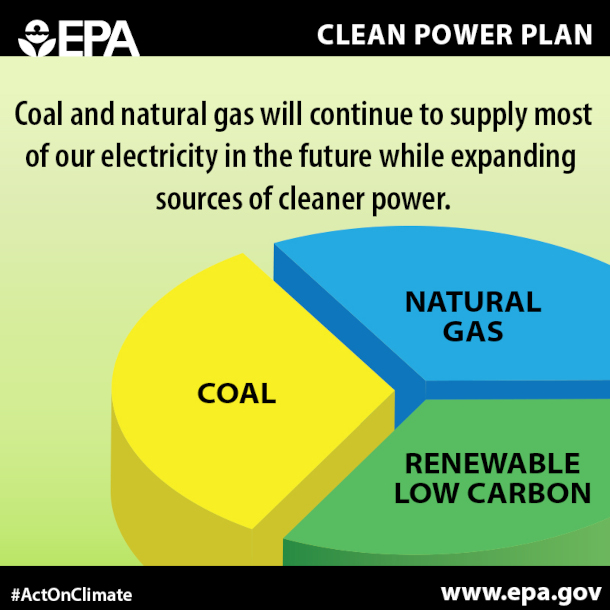
An infographic from 2014 explaining the Obama administration’s Clean Power Plan, which the Supreme Court stayed in early 2016. (Image: US Environmental Protection Agency, public domain)
PARENTEAU: I have to say, Steve, that, you know, West Virginia has led the charge from day one against EPA's authority. I mean, West Virginia, was even arguing EPA had no authority whatsoever to regulate emissions from coal fired power plants. And obviously, West Virginia is a major coal state, you get that. But it's frankly more ideological than that. All of the challengers to the Clean Power Plan, and that have appealed to the Supreme Court, they all resent EPA giving them directions on how to transition the energy source. They're not taking any actions on their own. They could be doing that, but they're not. But they're also not supporting what EPA is trying to do. So there's no other way to describe this than that. It is a political fight. And it's about states versus EPA, and who's in charge, and so forth. And it's not rational.
CURWOOD: So Pat, how do you read the justices? How do you think this is going to be decided based on what you heard during the oral arguments at the Supreme Court the other day?
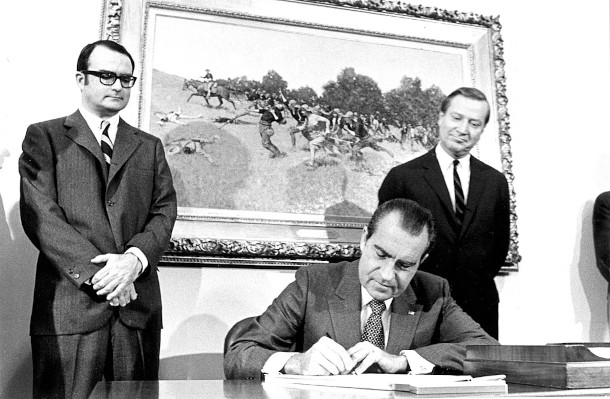
President Nixon signing the Clean Air Act in 1970. Looking on are EPA Administrator William Ruckelshaus and Russell E. Train, Chairman of the Council on Environmental Quality. (Photo: White House Photo Office, public domain)
PARENTEAU: So it was a very active bench. The argument went well over the time that was allotted, almost all the justices participated. And the government, through the Solicitor General, made a very strong argument that the court really didn't have jurisdiction over the case at all, partly because there's no rule on the books to review. But even more importantly, because there was no injury to the petitioners: the states and some of the coal industry that were co-petitioners. And that's because there's no rule on the books, nobody has to do anything at this point. What they're arguing, the petitioners, is, well, we can't trust the Biden administration when they say they're not going to revive the Clean Power Plan. They might. They just might do that. So because they might do that the case should stay alive. That's a really weak, pitiful, frankly, argument. I mean, an environmental group making an argument like that would be tossed out on their ear. But this court, my first prediction is, they're not going to dismiss the case. They're not going to stay their hand the way they should and wait for EPA's rule. They're going to issue a decision. What's the decision going to be? There's several possibilities. For sure, I think, they're going to say a lot of bad things about the Clean Power Plan. Justice Kavanaugh, when he was on the DC Circuit, heard arguments challenging the Clean Power Plan, and he showed his cards very clearly. He would use the major question doctrine to strike down the Clean Power Plan if in fact it was presented to the court. So we can be sure the court is going to be very negative about EPA's authority to require shift to renewable energy, wind or solar or anything else. The real question for me is, are they going to buy into this argument that EPA can only regulate inside the fence line? What it means is, you can only regulate at individual sources. I'm not sure what the court's going to do on that. Kavanaugh, you know, was asking a lot of hard questions about whether that made sense. The government, the Solicitor General, who was terrific, she pointed to the fact that the Clean Power Plan, not only was it never in effect, the goals of the Clean Power Plan have already been exceeded. The industry itself, because of the major transformations underway in the energy sector, have already exceeded the 30% reduction in emissions that the Clean Power Plan had established. So, you know, she made an incredibly powerful argument, I heard, that this major question doctrine, which a lot of us are really concerned about, really doesn't apply here. She just might be able to get Justice Roberts, maybe Justice Barrett, even, and who knows, maybe even Justice Kavanaugh, at least to agree that the major question doctrine doesn't oust EPA of authority to shape a rule. Maybe a rule that doesn't require transition to renewable energy, but maybe a rule that at least allows things like emissions trading and averaging, which would still accomplish a lot of reduction.
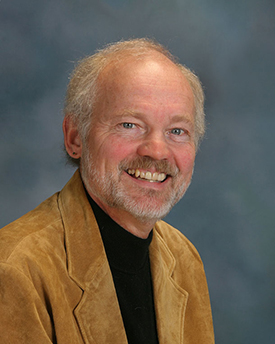
Former EPA Regional Counsel Pat Parenteau teaches environmental law at Vermont Law School (Photo: Courtesy of Vermont Law School)
CURWOOD: Hey, Pat, before you go, President Biden recently announced that Court of Appeals Judge Ketanji Brown Jackson is his pick to replace retiring Supreme Court Justice Stephen Breyer. What do we know about how she might approach cases involving the environment or climate?
PARENTEAU: Well, this is a very careful, brilliant jurist. She takes cases on their facts, on their legal merits. And she delves deeply into the record, that underlies the decisions that she's reviewing. She's, she does the work. And so, you know, if the government or the environmental plaintiff has made their case, she rules with them, and she has. When, on the other hand, there's a precedent that answers the question in the case, she goes with the precedent. It's probably a good thing, first of all, that we're getting a black woman on the court, that's obviously a historic occasion. But it's probably a good thing, that we're getting someone with a track record of being able to work with a lot of different perspectives, and maybe, over time, pull one or two of those younger, conservative members of the court her way. I'm not naive enough to think that's going to happen a lot. But maybe it'll happen more often than not if she hadn't been confirmed, and she's just going to make a tremendous addition to the Supreme Court.
CURWOOD: Pat Parenteau is a Professor of Environmental Law at the Vermont Law School and former EPA Regional Council. Pat, thanks so much today for our discussion.
PARENTEAU: It's a pleasure, Steve.
CURWOOD: We'll talk to you again real soon.
Links
Listen to our interview on the landmark climate case Massachusetts v. EPA
Living on Earth wants to hear from you!
Living on Earth
62 Calef Highway, Suite 212
Lee, NH 03861
Telephone: 617-287-4121
E-mail: comments@loe.org
Newsletter [Click here]
Donate to Living on Earth!
Living on Earth is an independent media program and relies entirely on contributions from listeners and institutions supporting public service. Please donate now to preserve an independent environmental voice.
NewsletterLiving on Earth offers a weekly delivery of the show's rundown to your mailbox. Sign up for our newsletter today!
 Sailors For The Sea: Be the change you want to sea.
Sailors For The Sea: Be the change you want to sea.
 The Grantham Foundation for the Protection of the Environment: Committed to protecting and improving the health of the global environment.
The Grantham Foundation for the Protection of the Environment: Committed to protecting and improving the health of the global environment.
 Contribute to Living on Earth and receive, as our gift to you, an archival print of one of Mark Seth Lender's extraordinary wildlife photographs. Follow the link to see Mark's current collection of photographs.
Contribute to Living on Earth and receive, as our gift to you, an archival print of one of Mark Seth Lender's extraordinary wildlife photographs. Follow the link to see Mark's current collection of photographs.
 Buy a signed copy of Mark Seth Lender's book Smeagull the Seagull & support Living on Earth
Buy a signed copy of Mark Seth Lender's book Smeagull the Seagull & support Living on Earth

